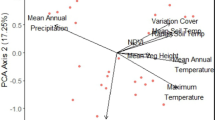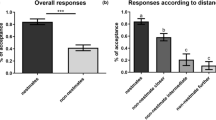Abstract
We investigated excavation and nest site choice across sediment-filled cavities in the ant Temnothorax albipennis. Colonies were presented with sediment-filled cavities, covering a spectrum from ones that should be quick to excavate but will form a weak enclosing wall to those that should be slow to excavate but form a strong wall. Overall, colonies only showed a significant preference for cavities that were fastest to excavate over those that were slowest. The speed of decision making and moving appears paramount over the suitability of the sediment for forming an enclosing wall. The mechanism behind the choice is the differential between the rates at which alternatives are excavated and accumulate ants. The rates for a particular type of cavity were unaffected by the type with which it was paired. This suggests that there is no significant competition between sites during the decision-making process. Certain colonies were able consistently to discriminate across more closely matched alternatives. These colonies required a greater number of ants to be present and took longer before beginning to move. A race is run between alternatives to become habitable but the process may be tuned across colonies such that it may run for longer and an incorrect or split decision is less likely.







Similar content being viewed by others
References
Aleksiev AS, Longdon B, Christmas MJ, Sendova-Franks AB, Franks NR (2007a) Individual choice of building material for nest construction by worker ants and the collective outcome for their colony. Anim Behav 74:559–566
Aleksiev AS, Sendova-Franks AB, Franks NR (2007b) The selection of building material for wall construction by ants. Anim Behav 73:779–788
Aleksiev AS, Longdon B, Christmas MJ, Sendova-Franks AB, Franks NR (2008) Individual and collective choice: parallel prospecting and mining in ants. Naturwissenschaften 95:301–305
Blott SJ, Pye K (2001) GRADISTAT: a grain size distribution and statistics package for the analysis of unconsolidated sediments. Earth Surf Proc Land 26:1237–1248
Bollazzi M, Roces F (2007) To build or not to build: circulating dry air organizes collective building for climate control in the leaf-cutting ant Acromyrmex heyeri. Anim Behav 74:1349–1355
Bollazzi M, Roces F (2010a) Leaf-cutting ant workers (Acromyrmex heyeri) trade off nest thermoregulation for humidity control. J Ethol 28:399–403
Bollazzi M, Roces F (2010b) Control of nest water losses through building behavior in leaf-cutting ants (Acromyrmiex heyeri). Insect Soc 27:267–273
Bollazzi M, Kronenbitter K, Roces F (2008) Soil temperature, digging behaviour, and the adaptive value of nest depth in South American species of Acromyrmex leaf-cutting ants. Oecologia 158:165–175
Brockmann HJ (1979) Nest site selection in the golden digger wasp, Sphex ichneumoneus L. (Sphecidae). Ecol Entomol 4:211–224
Camazine S, Deneubourg J-L, Franks NR, Sneyd J, Theraulaz G, Bonabeau E (2001) Self-organization in biological systems. Princeton University Press, Princeton
Cassill DL, Tschinkel WR, Vinson SB (2002) Nest complexity, group size and brood rearing in the fire ant, Solenopsis invicta. Insect Soc 49:158–163
Coe AL (1996) Unconformities within the Portlandian Stage of the Wessex Basin and their sequence-stratigraphical significance. In: Hesselbo SP, Parkinson DN (eds) Sequence stratigraphy in British geology. Geol Soc Spec Publ 103:109–143
Cole BJ, Smith AA, Huber ZJ, Wiernasz DC (2010) The structure of foraging activity in colonies of the harvester ant, Pogonomyrmex occidentalis. Behav Ecol 21:337–342
Dashtgard SE, Gingras MK, Pemberton SG (2008) Grain-size controls on the occurrence of bioturbation. Palaeogeogr Palaeoclimatol Palaeoecol 257:224–243
Dawkins R (1999) The extended phenotype: the Long Reach of the Gene, revised ed. Oxford University Press, Oxford
Folgarait PJ (1998) Ant biodiversity and its relationship to ecosystem functioning: a review. Biodivers Conserv 7:1221–1244
Folk RL, Ward WC (1957) Brazos river bar: a study in the significance of grain size parameters. J Sediment Petrol 27:3–26
Franks NR, Deneubourg J-L (1997) Self-organizing nest construction in ants: individual worker behaviour and the nest's dynamics. Anim Behav 54:779–796
Franks NR, Wilby A, Silverman B, Tofts C (1992) Self-organizing nest construction in ants: sophisticated building by blind bulldozing. Anim Behav 44:357–375
Franks NR, Dornhaus A, Fitzsimmons JP, Stevens M (2003a) Speed versus accuracy in collective decision-making. Proc R Soc Lond B 270:2457–2463
Franks NR, Mallon EB, Bray HE, Hamilton MJ, Mischler TC (2003b) Strategies for choosing between alternatives with different attributes: exemplified by house-hunting ants. Anim Behav 65:215–223
Franks NR, Dornhaus A, Best CS, Jones EL (2006) Decision-making by small and large house-hunting ant colonies: one size fits all. Anim Behav 72:611–616
Franks NR, Hardcastle KA, Collins S, Smith FD, Sullivan KME, Robinson EJH, Sendova-Franks AB (2008) Can ant colonies choose a far-and-away better nest over an in-the-way poor one? Anim Behav 76:323–334
Hansell MH (2005) Animal architecture. Oxford University Press, Oxford
Heneberg P (2009) Soil penetrability as a key factor affecting the nesting of burrowing birds. Ecol Res 24:453–459
Jones CG, Lawton JH, Shachak M (1994) Organisms as ecosystem engineers. Oikos 69:373–386
Jouquet P, Dauber J, Lagerlöf J, Lavelle P, Lepage M (2006) Soil invertebrates as ecosystem engineers: intended and accidental effects on soil and feedback loops. Appl Soil Ecol 32:153–164
Kinlaw A (1999) A review of burrowing by semi-fossorial vertebrates in arid environments. J Arid Environ 41:127–145
Kleineidam C, Roces F (2000) Carbon dioxide concentrations and nest ventilation in nest of the leaf-cutting ant Atta vollenweideri. Insect Soc 47:241–248
Langridge EA, Franks NR, Sendova-Franks AB (2004) Improvement in collective performance with experience in ants. Behav Ecol Sociobiol 56:523–529
Mallon EB, Pratt SC, Franks NR (2001) Individual and collective decision making during nest site selection by the ant Leptothorax albipennis. Behav Ecol Sociobiol 50:352–359
Meyer ST, Leal IR, Tabarelli M, Wirth R (2011) Ecosystem engineering by leaf-cutting ants: nest of Atta cephalotes drastically alter forest structure and microclimate. Ecol Entomol 36:14–24
Minter NJ, Franks NR, Robson-Brown KA (2012) Morphogenesis of an extended phenotype: four-dimensional ant nest architecture. J R Soc Interface 9:586–595
Möglich M (1978) Social organization of nest emigration in Leptothorax (Hym. Form.). Insect Soc 25:205–225
Potts SG, Willmer P (1997) Abiotic and biotic factors influencing nest-site selection by Halictus rubicundus, a ground-nesting halictine bee. Ecol Entomol 22:319–328
Pratt SC (2005) Behavioral mechanisms of collective nest-site choice by the ant Temnothorax curvispinosus. Insect Soc 52:383–392
Pratt SC, Mallon EB, Sumpter DJT, Franks NR (2002) Quorum sensing, recruitment and collective decision-making during colony emigration by the ant Leptothorax albipennis. Behav Ecol Sociobiol 52:117–127
Pratt SC, Sumpter DJT, Mallon EB, Franks NR (2005) An agent based model of collective nest choice by the ant Temnothorax albipennis. Anim Behav 70:1023–1036
R Core Team (2012) R: a language and environment for statistical computing. R Foundation for Statistical Computing, Vienna, Austria. ISBN 3-900051-07-0. http://www.R-project.org/.
Robinson EJH, Smith FD, Sullivan KME, Franks NR (2009) Do ants make direct comparisons? Proc R Soc Lond B 276:2635–2641
Robinson EJH, Franks NR, Ellis S, Okuda S, Marshall JAR (2011) A simple threshold rule is sufficient to explain sophisticated collective decision-making. PLoS One 6:e19981
Schepps J, Lohr S, Martin TE (1999) Does tree hardness influence nest-tree selection by primary cavity excavators? Auk 116:658–665
Seeley TD, Buhrman SC (2001) Nest-site selection in honey bees: how well do swarms implement the “best-of-N” decision rule? Behav Ecol Sociobiol 49:416–427
Sendova-Franks AB, Franks NR (1993) Task allocation in ant colonies within variable environments (a study of temporal polyethism: experimental). B Math Biol 55:75–96
Sosa B, Brazeiro A (2012) Local and landscape-scale effects of an ant nest construction in an open dry forest of Uruguay. Ecol Entomol 37:252–255
Toffin E, Kindekens J, Deneubourg JL (2010) Excavated substrate modulates growth instability during nest building in ants. Proc R Soc B 277:2617–2625
Walker FM, Taylor AC, Sunnucks P (2007) Does soil type drive social organization in southern hairy-nosed wombats? Mol Ecol 16:199–208
Wilson EO (1971) The insect societies. Harvard University Press, Cambridge, MA
Yuan H-W, Burt DB, Wang L-P, Chang W-L, Wang M-K, Chiou C-R, Ding T-S (2006) Colony site choice of blue-tailed bee-eaters: influences of soil, vegetation and water quality. J Nat Hist 40:485–493
Acknowledgments
We are grateful for the practical assistance and comments of the members of the University of Bristol Ant Lab. NJM was supported by an Association for the Study of Animal Behaviour Research Grant (to NRF).
Author information
Authors and Affiliations
Corresponding author
Additional information
Communicated by W. O. H. Hughes
Electronic supplementary material
Below is the link to the electronic supplementary material.
ESM 1
DOC 80.0 kb
Rights and permissions
About this article
Cite this article
Minter, N.J., Sendova-Franks, A.B. & Franks, N.R. Nest-seeking rock ants (Temnothorax albipennis) trade off sediment packing density and structural integrity for ease of cavity excavation. Behav Ecol Sociobiol 67, 1745–1756 (2013). https://doi.org/10.1007/s00265-013-1582-x
Received:
Revised:
Accepted:
Published:
Issue Date:
DOI: https://doi.org/10.1007/s00265-013-1582-x




